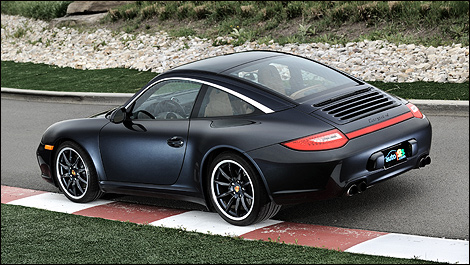
The name Targa was first seen on a 911 in 1967, only two years after the 911 broke cover. Meant as a mid-way version of the 911, the Targa was created, in part, as an alternative to a convertible. Its removable roof panel and plastic rear window were what set it apart then. Today, the 997-series Targa sports a large glass roof that slides beneath the rear window, a trend that began with the 993 Targa from the mid-nineties.
Carrera vs Targa
So, all of this is nice (duh!) but does this wannabe 911 coupe behave as would a 911 Carrera around a track? Keep in mind that the Targa weighs in at 80 kg (or 176 lbs) more than the Carrera 4. This, and the fact that the extra weight finds itself overhead, therefore elevating the centre of gravity above that of the Coupe, could upset the Carrera's poise.
On a city street or highway for that matter, it would be nearly impossible to discern any gain in mass as most people (I do say most...) do not clip apexes when they turn up Yonge from Dundas or ride on two wheels when merging onto the 440 West from the 15 North. How do we figure this on out then? I've already said it: on a track. In a rare opportunity, I got to punch the 911 Targa 4 at Sanair, a well-known track east of Montreal and at Calabogie, a relatively new motorsports park north-west of Ottawa.
Carrera vs Targa part II
First, let it be known that there are but subtle differences between the Carrera 4 and Targa 4, consisting in the badging and glass roof. This then, means that they both share the 3.6L flat 6-cylinder engine that puts out 345 hp and 288 lb-ft of torque. As we all know, “4” stands for AWD and, as with all 911s, a 6-speed manual gearbox is standard. Four-piston alloy callipers and ventilated brake discs find themselves on the pair.
At the track
Speaking of the track, the Sanair Complex is not renowned for its clean surfaces and smooth stretches. In most situations, the Targa did little but cope with the changing tarmac conditions but, on a few occasions where rapid-fire switchbacks were on the menu, the car became somewhat twitchy. This is not unusual for the rear-engined car, however, and as a side-note, the Volkswagen GTI I was also tracking displayed none of these characteristics.
Calabogie is a very different track where stretches are short and corners are never-ending. The Targa's rear-weight bias was constantly kept in-check so long as throttle modulation remained linear. Nowhere on this circuit did the 911 have the shakes, but it could never match the prowess of the Boxster Spyder that I also tracked on the same day.
Revelations
Three items really came to the surface after both events. First, the non-S is quick but far from offering the neck-snapping acceleration inherent in an S. For the money, I'd go S every time. Second, the car’s brakes were flawless! Flawless I say! Sanair has a long straight where ¼-mile runs are performed and where I would regularly reach 200 km/h, but whaling on the middle pedal would kill the car's momentum every time. Never did the brakes let me down or have me in doubt. The GTI and Mazdaspeed3 (also tracked at the same time) did very poorly by comparison. And lastly, I was somewhat let-down by the steering's lack of bite. Perhaps it had to do with my back-to-back drives with the Spyder, but the 911's steering felt light.
Porsche life
911 cabins always meet expectations. The seats hold you in place with the firm yet understanding grip of the school principal after you've been caught kicking the cafeteria bathroom paper dispenser because you could... (don't ask). The pedals are perfectly spaced for heel-toeing and the shifter can be manipulated as opposed to beaten into submission. Fit and finish is just about perfect and the gauges provide unadulterated information.
Despite all of this, I don't think I would ever spring for the Targa. Personally, I'm no fan of sunroofs and would simply get a Carrera 4 ($104,000), put the $9,700 difference towards the aforementioned options ($2,850 PASM, $1,310 Sport Chrono Plus and $3,830 Sports Exhaust System) and throw in the leather sport seats for an extra $1,090.
As a final note, every Porsche, nay, every car, should be equipped with Porsche's sport performance exhaust; the way it strong-arm's the exhaust gases into making them sound so thoroughly seductive would bring every neighbourhood closer to Heaven... In my books anyhow...
~ Mathieu St-Pierre
Click the title for the source





0 comments:
Post a Comment
Note: Only a member of this blog may post a comment.